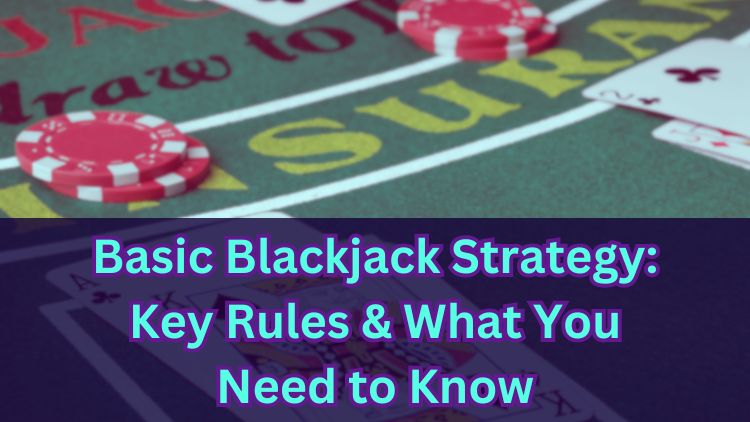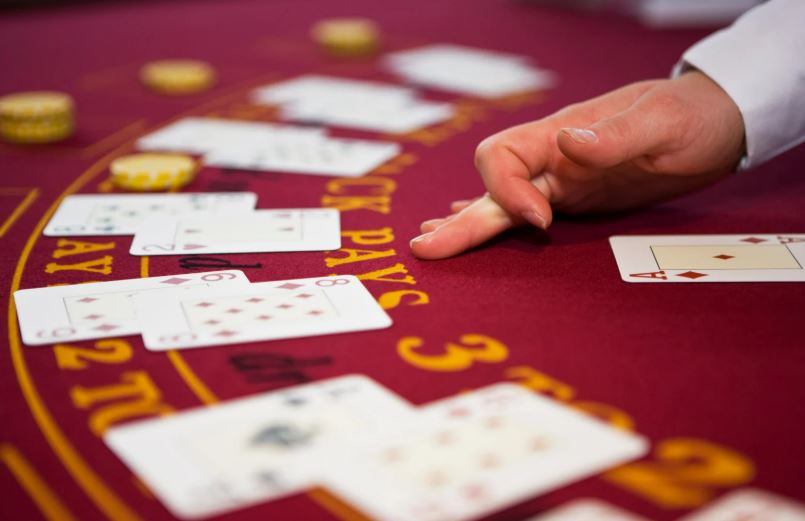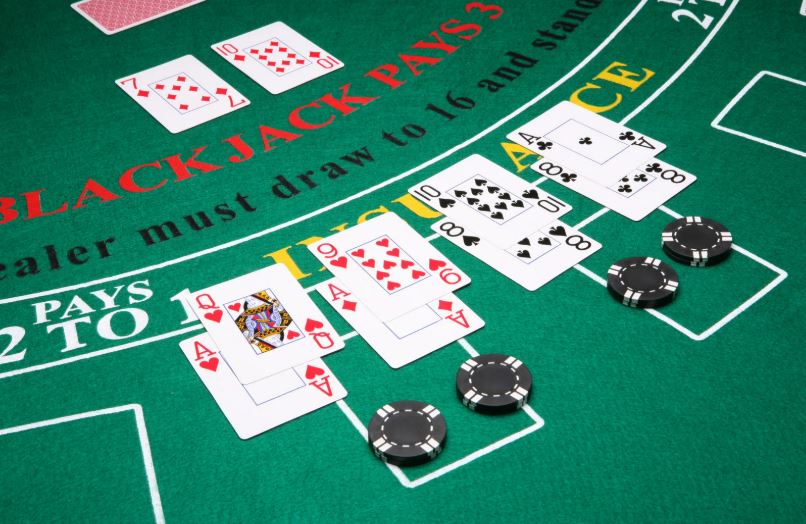
Blackjack is one of the most well-known card games found in casinos across the UK, both in person and online. It is often enjoyed by people who appreciate its simple rules and the quick pace of each round. While the game looks straightforward, there are details that shape how each hand plays out.
Understanding how blackjack works and what the main rules are could help you feel more confident at the table. In this article, you will find the basics presented clearly, with practical context and no jargon.
If you are new and curious, or just looking to sharpen up, you will find clear explanations that make the next hand easier to follow.
What Is Basic Blackjack Strategy?
Basic blackjack strategy is a set of decisions based on maths that helps reduce the house edge over the long run. It was developed by running computer simulations across millions of hands to see which choices most often lead to stronger outcomes. The strategy sets out when it makes sense to hit, stand, split or double down, depending on your cards and the dealer’s face-up card.
Instead of acting on feelings or impulse, this method uses probabilities. Some moves carry a better expected result in specific situations, which is why the same hand can be played differently depending on what the dealer shows.
The aim is not to predict the result or guarantee a win, but to guide your decisions so they are consistent. With sound play, the average house edge for blackjack is often around 0.5%, compared to a higher edge when playing without a plan.
Rules can vary from table to table, such as the number of decks or whether the dealer hits on a soft 17. A quick check of the rules before you start could help you apply the right version of the strategy for that game.
Players should always remember to gamble responsibly and within their means- never wager more than you can afford to lose.
Key Rules Every Player Should Follow
To begin a round of blackjack, you place a wager using casino chips or digital credits. Most tables in the UK set a minimum bet, often starting at £1 or £5 per hand.
Each player is dealt two cards. The dealer also gets two cards, but only one is face-up. Your goal is to reach a hand total as close as possible to 21 without going over.
Number cards are worth their face value. Face cards, which are Jack, Queen and King, are worth 10. An Ace can count as either 1 or 11, depending on which total helps your hand. If your first two cards are an Ace and a 10-value card, that is a blackjack.
You then decide what to do next. You can hit to take an extra card, or stand to keep your current hand. Some tables also allow you to split pairs into separate hands or double down for an extra wager and one more card. If your hand goes over 21, this is a bust, which means you lose that round.
Dealers follow fixed actions. In many games the dealer takes more cards on 16 or less and stops at 17 or higher, although some tables require the dealer to hit on a soft 17.
When Should You Hit or Stand in Blackjack?
Deciding whether to hit or stand depends on your total and the dealer’s face-up card. Many players rely on charts built from simulations to keep these choices consistent. 
Low totals, such as 8 or below, rarely bust with one extra card. That is because there are many 10-value cards in the deck but also plenty of lower cards that keep you safe. By contrast, totals between 12 and 16 are more delicate. When the dealer shows a strong card like a 7, 8, 9, 10 or Ace, hitting is often the better way to avoid being overtaken by a dealer total that ends high. If the dealer shows a weaker card like 4, 5 or 6, standing on 12 through 16 can be sensible because the dealer must draw and risks busting.
A total of 17 or more is generally strong enough to stand, especially against a dealer’s lower upcard. Soft hands, which include an Ace counted as 11, behave differently. A soft 17 or soft 18 can absorb an extra card without busting, so hitting or even doubling in some situations can be correct. The basic strategy chart sets out the exact spots.
When Is the Right Time to Double Down?
Doubling down lets you increase your wager after the first two cards in exchange for exactly one extra card. It is designed for situations where the extra stake has a favourable expected return.
Totals of 10 or 11 are the classic candidates. With so many 10-value cards in the shoe, your single draw often lands you on 20 or 21, which pressures the dealer. Totals of 9 can also be good doubling hands when the dealer shows a weaker card, such as 3, 4, 5 or 6, because the dealer must draw and you have room to improve.
Table rules matter here. Some games allow doubling on any two cards, others restrict it to totals of 9, 10 or 11, and some permit doubling after a split. Knowing which options are available on your table helps you line up your doubles with the strategy that fits those rules.
How Does Splitting Pairs Work in Blackjack?
When your first two cards have the same value, such as two 8s or two Kings, you can split them into two hands. You place a second wager equal to your original bet, then the dealer gives one extra card to each new hand.  You then play each hand in turn.
You then play each hand in turn.
Splitting changes the shape of the hand. For example, splitting 8s turns a difficult 16 into two fresh starting hands of 8, which can often perform better. Aces are another common split because each Ace can become a strong soft total with a 10-value card. By contrast, splitting 10-value cards usually weakens a strong starting 20, so most strategies keep them together.
Rules sometimes limit what happens after a split. Many tables allow only one card on split Aces, and some prevent doubling after a split. Re-splitting pairs may also be capped. A quick scan of the table rules could tell you what is possible before you commit to the extra wager.
Should You Ever Take Insurance in Blackjack?
Insurance is a side bet offered when the dealer’s face-up card is an Ace. You can place an extra wager, typically half your main bet, on the chance that the dealer’s hidden card is worth 10. If the dealer does have a blackjack, the insurance bet pays 2 to 1.
Because there are fewer 10-value cards than non-10s in a full deck, the insurance bet does not usually offer a favourable long-term return. It is mainly presented as a way to offset the main hand when the dealer’s Ace is showing, but over time most players find it increases overall costs rather than reducing them.
Basic Strategy Chart Explained
A basic strategy chart is a visual guide that tells you the recommended move for each combination of your hand and the dealer’s face-up card. It is built from computer simulations of millions of blackjack hands to map the best decision in each situation.
The chart is laid out as a grid. One side lists your totals, split into hard totals, which do not count an Ace as 11, soft totals, which do, and pairs. The other side shows the dealer’s visible card from 2 to Ace. You find your hand on one axis and the dealer’s card on the other, then read off whether to hit, stand, split or double.
For example, a pair of 8s against a dealer 6 usually points to splitting. A soft 18 against a 9 often recommends hitting, because improving to 19, 20 or 21 is possible while a stand can leave you behind if the dealer finishes strong.
Common Mistakes to Avoid When Using Basic Strategy
Some players try to rely on memory and skip checking the chart. The chart exists to remove guesswork, so referring to it is a strength, not a weakness.
Another frequent slip is ignoring the table rules in front of you. The dealer’s action on soft 17, whether doubling after a split is allowed, or how many times you can re-split can alter the correct move in a handful of spots.
It is also easy to read patterns into previous outcomes. Believing that a run of results makes a certain outcome more likely on the next hand is known as the gambler’s fallacy. Each hand is independent, so it could be a good idea to keep decisions anchored to your current total and the dealer’s upcard.
Finally, rushing leads to misclicks online or snap decisions in person. Taking a moment to read your hand, check the dealer’s card and confirm the chart entry could lead to more consistent choices.
Play Blackjack Games Online
If you are interested in exploring blackjack at your own pace, Pay By Mobile Casino offers a range of online tables suitable for all experience levels. You can browse live dealer rooms, classic variants and games that clearly set out deck numbers and house rules within their descriptions.
The sign-up process is straightforward, and mobile payments are supported, so you can add funds from your device. You will also find tables with low minimums, making it easier to choose a level that suits your budget.
Information about minimum and maximum bets, plus the full game rules, is available before you play. We are licensed by the UK Gambling Commission (UKGC) and provide secure payments and optional account tools, such as deposit limits and time-outs. Whether you are learning the basics or refining your play, our tables offer a clear and convenient way to put strategy into practice.
**The information provided in this blog is intended for educational purposes and should not be construed as betting advice or a guarantee of success. Always gamble responsibly.
*All values (Bet Levels, Maximum Wins etc.) mentioned in relation to these games are subject to change at any time. Game features mentioned may not be available in some jurisdictions.
